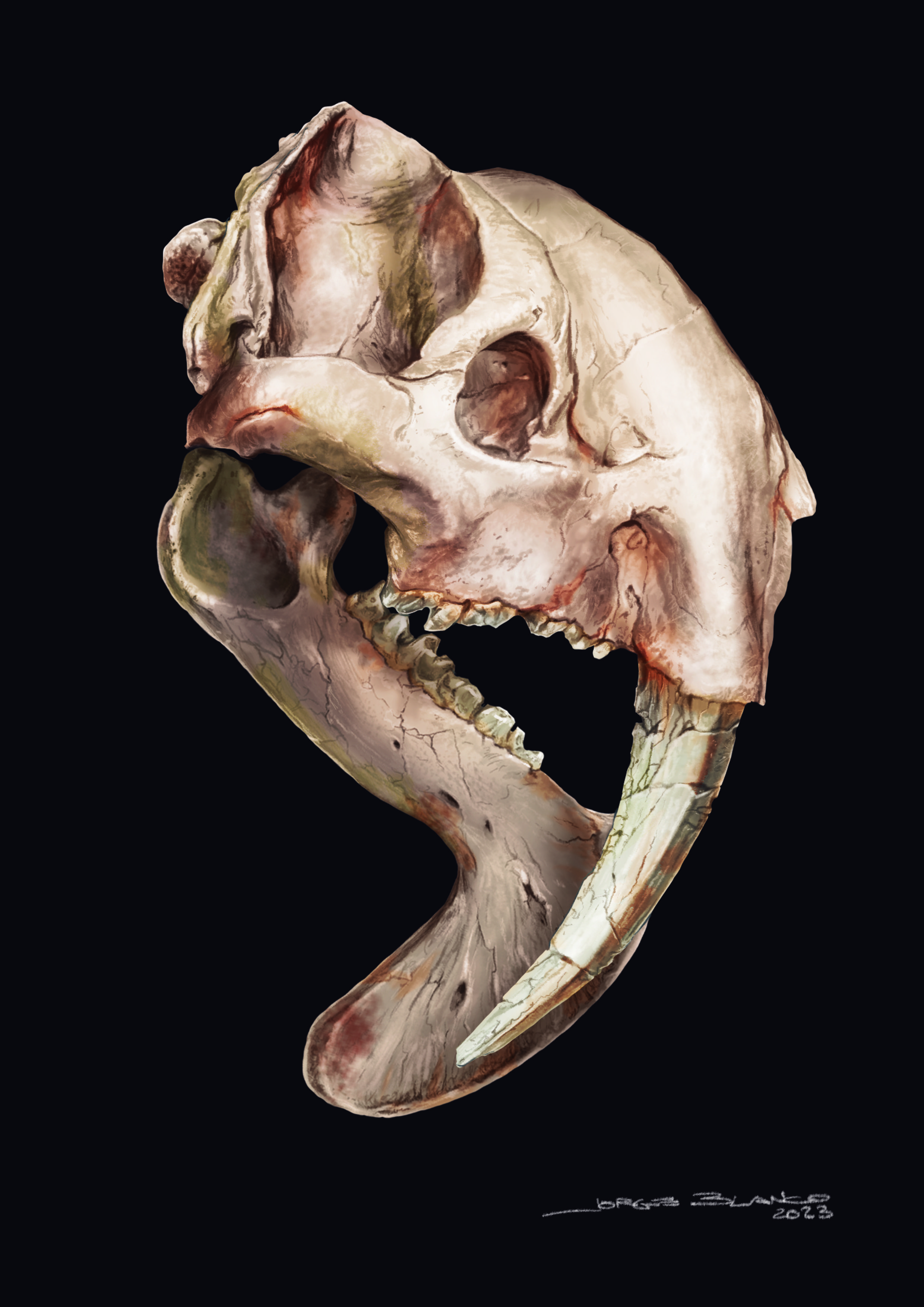A “marsupial sabertooth” roamed the jungles of South America until its extinction 3 million years ago. Thylacosmilus atrox was a member of the Sparassondonta, a group of mammalian carnivores that are related to today’s marsupials. Thought to have weighed 100 kilograms (220 pounds), this creature had all the hallmarks of a successful ambush predator except for a deviation in one key feature. Thylacosmilus’ eyes were positioned on the side of its head much like a prey species, such as a cow or antelope, rather than facing forward like a typical top predator.
Eye position is a key adaptation for survival in all species. Cows and other herbivorous prey animals typically have eye sockets or orbits placed on the side of their heads giving them a wide field of vision and allowing them to look out for any sabertooth marsupials that might be sneaking up on them. By contrast, most predators have forward-facing eyes with sockets both facing the same direction on the face to enable stereoscopic, or 3D, vision. This adaptation helps the predator judge the distance from the prey before pouncing.
Thylacosmilus bucks this trend by being thought to be a large predator, while at the same time having a prey-like eye position – and now scientists think they have figured out why. Thylacosmilus is believed to have had a diet that was at least 70 percent meat suggesting it was a successful ambush predator. But the unusual position of the eye sockets on the side of the skull means that there was not enough overlap for its vision to integrate into 3D.
The answer to why the eyes are in such an unusual position for a predatory species also lies in the skull. In short, Thylacosmilus had enormous teeth that never stopped growing. Unlike a rodent such as a beaver, which has ever-growing teeth that are worn down by gnawing behavior, the roots of Thylacosmilus’ canines continued growing over the top of the skull. These canines were so large that they took up most of the room in the skull, meaning the eye positions were forced sidewards.
“You can’t understand cranial organization in Thylacosmilus without first confronting those enormous canines,” said lead author Charlène Gaillard, a Ph.D. student in the Instituto Argentino de Nivología, Glaciología, y Ciencias Ambientales (INAGLIA), in a statement. “They weren’t just large; they were ever-growing … This had consequences, one of which was that no room was available for the orbits in the usual carnivore position on the front of the face.”

A reconstruction of the skull of Thylacosmilus atrox shows the enormous canine teeth and eye socket position. Image Credit: © Jorge Blanco
By using CT scans and 3D reconstructions, the team compared Thylacosmilus’ eye position with other carnivores and mammals. A typical cat has an orbital convergence of around 65 degrees but Thylacosmilus was thought to have an orbital convergence value of only 35 degrees.
Despite this, researchers believe the eyes sat forward within the eye sockets, bulging out somewhat and therefore increasing that orbital convergence value by more than double. They also suggest that the eyeball diameter was greater in Thylacosmilus compared to other metatherians, further compensating.
“Thylacosmilus was able to compensate for having its eyes on the side of its head by sticking its orbits out somewhat and orienting them almost vertically, to increase visual field overlap as much as possible,” said co-author Analia M. Forasiepi, also in INAGLIA and a researcher in CONICET, the Argentinian science and research agency. “Even though its orbits were not favorably positioned for 3D vision, it could achieve about 70 percent of visual field overlap – evidently, enough to make it a successful active predator.”
Despite the strange morphology of the ancient sabertooth, the species managed to survive successfully as an ambush predator until around 3 million years ago.
“We may view it as an anomaly because it doesn’t fit within our preconceived categories of what a proper mammalian carnivore should look like, but evolution makes its own rules,” concluded Forasiepi.
The study is published in Communications Biology.
Source Link: Ancient Marsupial Sabertooth Had Teeth So Big Its Eyes Were Sticking Out Of Its Head